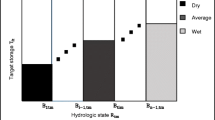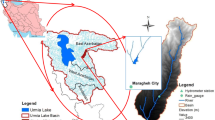Abstract
Considering the risks in water resources systems, one of the most crucial management solutions is to try to understand the effects of climate change components on water resources in the future. For this purpose and according to the change in water supply and demand, the management of water resource exploitation should be different compared to the past, and a new approach should be adopted. Considering the effects of climate change in the last few years in the Eyvashan dam basin, the water cycle algorithm (WCA) and particle swarm optimization (PSO) have been used to optimize the use of the dam reservoir. Reliability, resiliency, and vulnerability criteria have been used to analyze the performance of algorithms. The maximum amount of deficiency in the Eyvashan dam reservoir in methods WCA and PSO is equal to 10.08 and 21.35, respectively, from 2020 to 2021. The values of consumption versus release performed by each algorithm show that the WCA algorithm provided an average of 92.6% of watershed consumption and the PSO algorithm provided 86.2% of this amount. Due to the flood of the 2018–2019 period, in both algorithms, the reservoir volume has exceeded the maximum reservoir volume of the dam, which has overflowed by 3 and 6 MCM in WCA and PSO algorithms, respectively. The results indicate that the amount of release obtained from the WCA algorithm is very close to the total downstream requirements of the studied dam and will be a suitable response to the downstream agricultural and environmental needs in climate change conditions. Also, the results show that the WCA algorithm has a good speed in finding the optimal solution so that the average objective function of the WCA and PSO models has increased by 9.4% and 11.1%, respectively, compared to the global optimal solution.








Similar content being viewed by others
Data availability
The datasets generated during and/or analysed during the current study are available from the corresponding author on reasonable request.
References
Ashofteh P-S, Rajaee T, Golfam P (2017) Assessment of water resources development projects under conditions of climate change using efficiency indexes (EIs). Water Resour Manage 31(12):3723–3744. https://doi.org/10.1007/s11269-017-1701-y
Beiranvand B, Rajaee T (2022) Application of artificial intelligence-based single and hybrid models in predicting seepage and pore water pressure of dams: a state-of-the-art review. Adv Eng Softw (barking, Lond, Engl: 1992) 173:103268. https://doi.org/10.1016/j.advengsoft.2022.103268
Bilal RD, Pant M, Jain SK (2020) Dynamic programming integrated particle swarm optimization algorithm for reservoir operation. Int J Syst Assur Eng Manage 11(2):515–529. https://doi.org/10.1007/s13198-020-00974-z
Eberhart RC, Kennedy J (1995) A new optimizer using particle swarm theory. In: Proc., 6th symp. on micro machine and human science. IEEE Service Center, Piscataway, NJ, pp 39–43
Ehteram M, Mousavi S-F, Karami H, Farzin S, Emami M, Binti Othman F, Amini Z, Kisi O, El-Shafie A (2017) Fast convergence optimization model for single and multi-purposes reservoirs using hybrid algorithm. Adv Eng Inform 32:287–298. https://doi.org/10.1016/j.aei.2017.04.001
Eskandar H, Sadollah A, Bahreininejad A, Hamdi M (2012) Water cycle algorithm—a novel metaheuristic optimization method for solving constrained engineering optimization problems. Comput Struct 110–111:151–166. https://doi.org/10.1016/j.compstruc.2012.07.010
Haddad OB, Moravej M, Loáiciga HA (2015) Application of the water cycle algorithm to the optimal operation of reservoir systems. J Irrig Drain Eng 141(5):04014064. https://doi.org/10.1061/(asce)ir.1943-4774.0000832
Hashimoto T, Stedinger JR, Loucks DP (1982) Reliability, resiliency and vulnerability criteria for water resources system performance evaluation. Water Resour Res 18(1):14–20
He Y, Xu Q, Yang S, Liao L (2014) Reservoir flood control operation based on chaotic particle swarm optimization algorithm. Appl Math Model 38(17–18):4480–4492. https://doi.org/10.1016/j.apm.2014.02.030
Kong AL, Liang S, Li CL, Liang ZF, Chen Y (2017) Optimizing microgrid operation based on improved PSO. J Hohai Univ (nat Sci) 45(6):550–555. https://doi.org/10.3876/j.issn.1000-1980.2017.06.012. (in Chinese)
Nagesh Kumar D, Janga Reddy M (2007) Multipurpose reservoir operation using particle swarm optimization. J Water Resour Plan Manage 133(3):192–201. https://doi.org/10.1061/(asce)0733-9496(2007)133:3(192)
Nasir M, Sadollah A, Choi YH, Kim JH (2020) A comprehensive review on water cycle algorithm and its applications. Neural Comput Appl 32(23):17433–17488. https://doi.org/10.1007/s00521-020-05112-1
Qaderi K, Akbarifard S, Madadi MR, Bakhtiari B (2018) Optimal operation of multi-reservoirs by water cycle algorithm. Water Manage 171(4):179–190. https://doi.org/10.1680/jwama.16.00034
Roeva O, Angelova M, Zoteva D, Pencheva T (2020) Water cycle algorithm for modelling of fermentation processes. Processes (basel, Switzerland) 8(8):920. https://doi.org/10.3390/pr8080920
Sadollah A, Eskandar H, Lee HM, Yoo DG, Kim JH (2016) Water cycle algorithm: a detailed standard code. SoftwareX 5:37–43. https://doi.org/10.1016/j.softx.2016.03.001
Singh J, Banka H, Verma AK (2019) A BBO-based algorithm for slope stability analysis by locating critical failure surface. Neural Comput Appl 31(10):6401–6418. https://doi.org/10.1007/s00521-018-3418-0
Veeramani C, Sharanya S (2021) An improved evaporation rate-water cycle algorithm based genetic algorithm for solving generalized ratio problems. RAIRO Oper Res 55:S461–S480. https://doi.org/10.1051/ro/2020045
Verma AK, Jha MK, Gautam PK, Mishra AK, Vardhan H, Singh SK (2021) Prediction of thermal conductivity and damage in Indian Jalore granite for design of underground research laboratory. Neural Comput Appl 33(20):13183–13192. https://doi.org/10.1007/s00521-021-05944-5
Funding
No funding was received for this study.
Author information
Authors and Affiliations
Contributions
BB and TR contributed to the study conception and design. Material preparation, data collection, and analysis were performed by BB and TR. The first draft of the manuscript was written by behrang beiranvand. BB and TR read and approved the final manuscript.
Corresponding author
Ethics declarations
Conflict of interest
The authors declare they have no competing interests.
Ethical statement
The research was in accordance with a declaration of Helsinki standards.
Consent to participate
The manuscript is eligible for consent to participate.
Consent for publication
The manuscript is eligible for consent to publication.
Additional information
Publisher's Note
Springer Nature remains neutral with regard to jurisdictional claims in published maps and institutional affiliations.
Appendix A. Annual rainfall in different stations of the study area 1990–2021
Appendix A. Annual rainfall in different stations of the study area 1990–2021
Station | Dehno | Zagheh | Kakareza | Station | Dehno | Zagheh | Kakareza |
|---|---|---|---|---|---|---|---|
1990–1991 | 318.0 | 564 | 344 | 2008–2009 | 461.9 | 525 | 548 |
1991–1992 | 389.2 | 442.2 | 675 | 2009–2010 | 525.0 | 577 | 485 |
1992–1993 | 425.1 | 671 | 662 | 2010–2011 | 429.0 | 401 | 514 |
1993–1994 | 428.6 | 462 | 401 | 2011–2012 | 438.0 | 669 | 575 |
1994–1995 | 402.5 | 844 | 594 | 2012–2013 | 385.3 | 698 | 389.3 |
1995–1996 | 412.6 | 682 | 601.2 | 2013–2014 | 428.0 | 559.3 | 534 |
1996–1997 | 262.1 | 257.5 | 146 | 2014–2015 | 477.5 | 563.2 | 536.2 |
1997–1998 | 395.9 | 496 | 535 | 2015–2016 | 467.8 | 572 | 645 |
1998–1999 | 446.3 | 749 | 422.1 | 2016–2017 | 549.0 | 436.5 | 679.2 |
1999–2000 | 435.0 | 754 | 412.5 | 2017–2018 | 560.0 | 658 | 650.2 |
2000–2001 | 462.5 | 747 | 509.3 | 2018–2019 | 654.0 | 985 | 681.7 |
2001–2002 | 468.3 | 840 | 231.6 | 2019–2020 | 598.0 | 546 | 436.2 |
2002–2003 | 498.0 | 738 | 512.6 | 2020–2021 | 552.3 | 568 | 653 |
2003–2004 | 506.5 | 726 | 365.3 | Mean | 426.2 | 667.8 | 434.8 |
2004–2005 | 548.0 | 675.2 | 410.2 | Max | 548.0 | 859.0 | 675.0 |
2005–2006 | 358.9 | 854.9 | 209.9 | Min | 262.1 | 257.5 | 146.0 |
2006–2007 | 460.3 | 659.3 | 326.2 | Max–min | 285.9 | 601.5 | 529.0 |
2007–2008 | 454.0 | 859 | 468 |
Rights and permissions
Springer Nature or its licensor (e.g. a society or other partner) holds exclusive rights to this article under a publishing agreement with the author(s) or other rightsholder(s); author self-archiving of the accepted manuscript version of this article is solely governed by the terms of such publishing agreement and applicable law.
About this article
Cite this article
Beiranvand, B., Rajaee, T. Optimization of reservoir operation at Eyvashan dam using the water cycle algorithm with the approach of water resource management in climate changes conditions. Sustain. Water Resour. Manag. 9, 98 (2023). https://doi.org/10.1007/s40899-023-00875-6
Received:
Accepted:
Published:
DOI: https://doi.org/10.1007/s40899-023-00875-6




